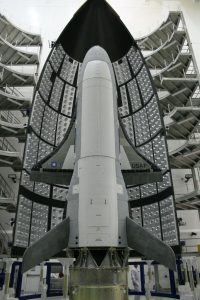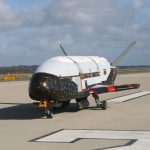It’s probably common knowledge that a new space age has been dawning for some years and is now rapidly expanding, with a new generation of bold entrepreneurs demonstrating that space no longer is the sole purview of governments. But prolific technology innovation also has been happening—until recently completely out of the public eye—under the direction of the Space Division in the Air Force Rapid Capabilities Office.
“It’s the biggest program [most people] never heard of, because it’s been shrouded largely in secrecy,” said Leeanne Caret, president and CEO of Boeing Defense, Space and Security.
Caret is referring to the Boeing-designed and built X-37B Orbital Test Vehicle (OTV), which has earned a reputation as the U.S.’s workhorse in the field of space experimentation, advancing technology at what may be an unrivaled pace, according to Boeing and the Air Force.

As the world’s only reusable, fully autonomous spaceplane—the vehicle has a lifting body-style and landing profile that’s similar to the long-retired Space Shuttle, but it’s one-fourth the size. The vehicle is designed to operate in low-earth orbit, 150 to 150 miles above the Earth, exploring reusable vehicle technologies that support long-term space objectives.
The OTV is the product of a unique partnership. Besides the Air Force Rapid Capabilities Office and Boeing, which also processes the vehicles, principal participants include the Air Force Space Experimentation Squadron, which operates the system; and technology developers, such as NASA and Air Force Research Laboratory (AFRL). Together, they have perfected the process of taking experiments from concept to launch, operating them to gather the required data and returning them to Earth for analysis.
The unmanned OTV has demonstrated many elements that mark a first use in space, including avionics designed to automate all de-orbit and landing functions. The spacecraft itself is built using a lighter weight composite structure rather than traditional aluminum, and it’s flying a new generation of thermal protection materials. Instead of hydraulics, it uses electro-mechanical actuation to operate brakes and flight controls.
Originally designed for flights lasting up to 270 days, the X-37B has exceeded expectations during the course of five orbital missions over the last 10 years, according to Randall Walden, director of the Air Force Rapid Capabilities Office. The vehicle has fielded innovations such as a new generation of high-temperature wing leading-edge tiles and toughened uni-piece fibrous refractory oxidation-resistant ceramic tiles, advanced conformal reusable insulation blankets, and toughened uni-piece fibrous insulation impregnated silica tiles. “It combines the best of aircraft and spacecraft into an affordable system that is easy to operate and maintain,” Walden said.

On the most recent mission, which ended in late 2019, OTV-5 set a 780-day endurance record. Innovation on the spacecraft doesn’t stop with the design and manufacture of the vehicle itself. There are many significant advancements that have provided broad benefit to both civil and military space.
On the OTV-5 mission, for example, an oscillating heat-pipe experiment demonstrated the potential to improve thermal performance of spacecraft by up to 200 times over traditional methods and also enable low-cost manufacturing techniques. The latter may offer a low-cost method to alleviate electronics thermal constraints and allow for increased processing power for commercial and military satellites.
The OTV-4 mission hosted dozens of materials samples for use on future civil space missions. “By exposing them to space and returning the samples to Earth, researchers gained valuable data about how they hold up in the environment in which the materials will have to operate,” said Miria Finckenor, principal investigator at NASA’s Marshall Space Flight Center.
Among upcoming science missions is an experiment to test whether different agricultural products will grow following long exposure to radiation. Scientists expect the experiment’s results to help them plan for how astronauts can be fed on long-endurance missions, such as travel to and from Mars and time spent exploring the planet.
“The X-37B continues to demonstrate the importance of a reusable spaceplane,” said Air Force Secretary Barbara Barrett said. “Each successive mission advances our nation’s space capabilities.”
The Washington, D.C.-based National Aeronautics Association recently awarded the X-37B the prestigious for the greatest American achievements in aeronautics and astronautics of 2019.
##
Editor: For more on the future of aerospace and defense, check out our story, Breaking the Barriers to Innovation
